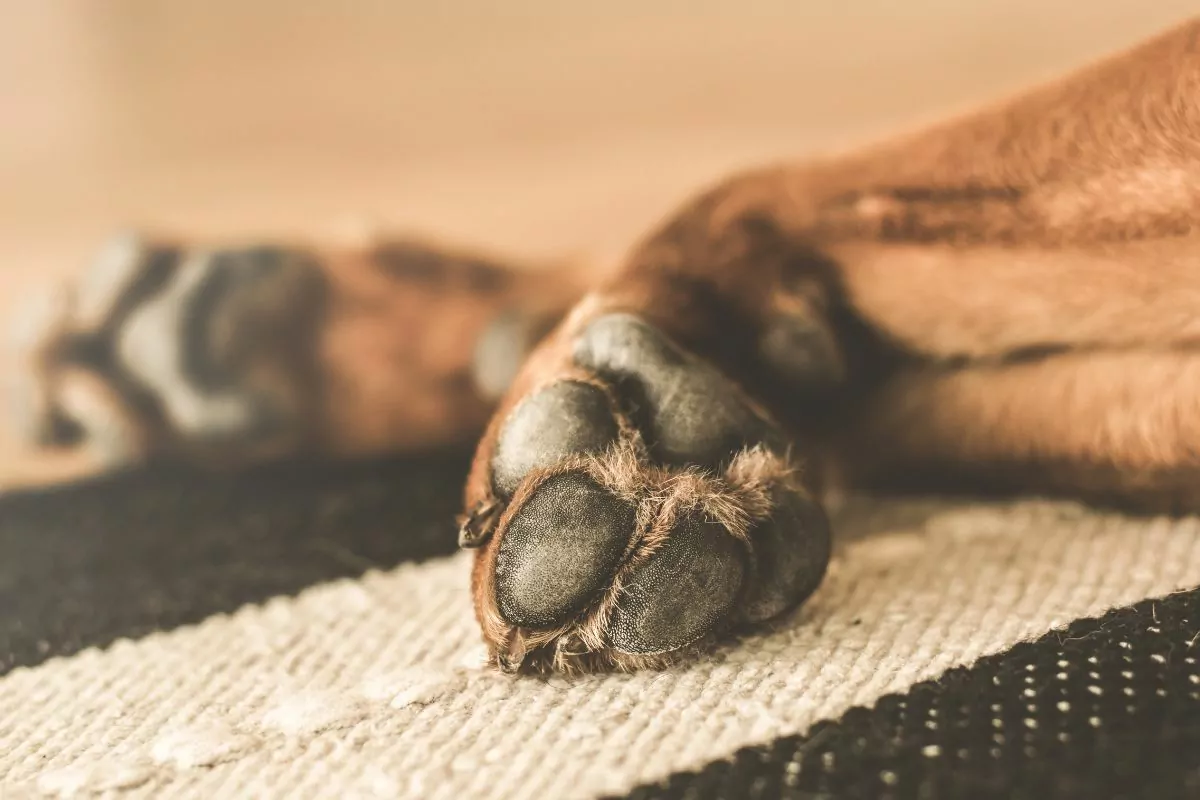When a Dog’s Paws Are Red Between the Toes
Discovering that your dog’s paws are red between the toes can concern any pet owner. While it’s essential to identify the cause of the redness, it’s equally important to take prompt action to alleviate any discomfort your furry friend may be experiencing.
In this guide, we’ll explore potential reasons behind red paws, preventive measures, and steps you can take to help soothe your dog’s discomfort.

Why Are My Dog’s Paws Red Between the Toes?
Understanding the potential causes of red paws on dogs and pododermatitis allows you to take prompt and targeted action, ensuring your canine companion receives the care they need for healthy and comfortable paws.
Here are common reasons why dogs may develop red paws and how to address each cause:
Allergies
Description: Dogs can develop allergies to environmental factors like pollen, grass, or certain cleaning products, leading to irritation and redness between the toes.
Symptoms: Redness, itching, licking, and sometimes swelling
Contact Dermatitis
Description: Exposure to irritants such as certain plants, chemicals, or abrasive surfaces can cause contact dermatitis, resulting in redness.
Symptoms: Redness, inflammation, and sometimes blistering
Yeast or Bacterial Infections
Description: Moist conditions between the toes create an environment conducive to yeast or bacterial growth. This leads to yeast infection, causing dog paws to turn red between the toes.
Symptoms: Redness, itching, odor, and sometimes discharge.
Injury or Trauma
Description: Minor cuts, abrasions, or the presence of foreign objects between the toes can cause redness and discomfort.
Symptoms: Visible wounds, limping, and excessive licking of the affected paw.
Autoimmune Disorders
Description: Certain autoimmune conditions can manifest with skin issues, including redness between the toes.
Symptoms: Variable and may include redness, hair loss, and changes in paw texture.
What Causes the Occurrence?
Various factors can cause redness in a dog’s paws, and pinpointing the issue’s root is the first step toward effective treatment. Here are some common causes of this occurrence and their symptoms:
Excessive Licking or Chewing
Red paws caused by dogs licking their toes are a common occurrence. This excessive licking or chewing of paws can be due to boredom, stress, or discomfort. This causes redness, saliva staining, and potential hair loss.
Dry or Cracked Pads
Harsh weather conditions or lack of moisture can lead to dry or cracked paw pads. This results in redness, rough or flaky pads, and potential discomfort.
Food Allergies
Certain ingredients in your dog’s diet may trigger allergic reactions. This may cause redness, itching, gastrointestinal issues, and sometimes ear infections.
Autoimmune Disorders
Certain autoimmune conditions can manifest with skin issues, including redness between the toes. This results in variable symptoms such as redness, hair loss, and changes in paw texture.
Available Treatment Options for Red Paws on Dogs
Dealing with an infected dog paw can be distressing, but the good news is that you can find numerous treatment options to address the issue and relieve your furry friend. The right treatment may vary depending on the root cause of the redness, and a careful approach is essential to ensure effective care.
Thorough Examination
Start by doing a thorough check of your dog’s paws. Check for signs of injury, foreign objects, or abnormalities between the toes.
Carefully inspect each paw, looking for wounds, cuts, or anything lodged between the toes. Gently clean the affected part with a mild, pet-safe antiseptic.
Consult Your Veterinarian
Seeking professional opinion is crucial to determining the root cause of the redness and receiving a tailored treatment plan. Schedule an appointment with your veterinarian for a comprehensive examination. Provide details about your dog’s symptoms, behavior, and recent environmental changes.
Identify and Address Underlying Causes
Treatments may vary based on the underlying cause, such as allergies, infections, or injuries. Work with your veterinarian to identify and address the specific cause. This may involve allergy testing, infection cultures, or X-rays to assess injuries.
Topical Treatments
Depending on the diagnosis, your veterinarian may recommend topical treatments to soothe the affected area. Follow your veterinarian’s guidance on using medicated creams, balms, or ointments suitable for your dog’s condition.
Medications
In cases of infections or autoimmune disorders, medications may be prescribed. Administer any prescribed medications according to your veterinarian’s instructions. Follow the recommended dosage and duration of treatment.
Adjust the Environment
Modifying your dog’s environment can be beneficial if the redness is due to allergens or irritants. Minimize exposure to potential allergens, use pet-friendly cleaning products, and create a clean living space for your dog.
Regular Paw Maintenance
Keeping your dog’s paws clean and dry is essential for ongoing care. Regularly trim excess hair between the toes to reduce moisture retention. Clean your dog’s paws after walks to remove potential irritants.
Protective Gear
In certain situations, protective gear can prevent further irritation. It also promotes faster healing of red dog paws in between toes. Consider using doggy boots during walks or in environments where irritants may be present. This can create an extra layer of protection for your dog’s paws.
Dietary Changes
In cases where allergies contribute to red paws, dietary adjustments may be recommended. Work with your veterinarian to identify food allergens and change your dog’s diet.
Monitoring and Follow-Up
Ongoing monitoring is crucial to ensure the effectiveness of the chosen treatment. Keep a close eye on your dog’s paws, observing for improvements or signs of relapse. Follow up with your veterinarian for additional guidance if needed.
Home Remedies for Redness Between Dog Toes
Having redness or sores on dog paws is a matter of utmost concern to any pet parent; before rushing to the vet, you can try several home remedies to soothe your furry friend’s discomfort.
These natural remedies can help address mild cases of redness and irritation. However, consulting with your veterinarian for persistent or severe issues is crucial.
Here are some home remedies for redness between dog toes that you can consider:
Epsom Salt Soak
Epsom salt has anti-inflammatory power and can help soothe irritated paws. Dissolve a tablespoon in warm water and soak your dog’s paws for five to ten minutes. Gently pat the paws dry afterward.
Chamomile Tea Compress
Chamomile has calming and anti-inflammatory properties. Brew one cup of strong chamomile tea and let it cool. Soak a clean, soft cloth in it and apply it as a compress to the affected paws.
Aloe Vera Gel
Aloe vera has soothing and healing properties. Apply pure aloe vera gel to the red areas between the toes. Ensure it’s free from added chemicals or alcohol.

Coconut Oil Massage
Coconut oil has moisturizing and antibacterial properties. Use a small amount of coconut oil to massage between your dog’s toes gently. Ensure they don’t lick it off immediately.
Oatmeal Bath
Oatmeal is known for its anti-inflammatory properties and can help soothe irritated skin. Mix oatmeal (finely ground) with water to create a paste. Apply the paste between the toes and let it sit for 10-15 minutes before rinsing.
Apple Cider Vinegar Rinse
Apple cider vinegar has antibacterial and antifungal elements. Blend apple cider vinegar and water in equal parts, and apply the solution between your dog’s toes with a cotton ball. Ensure they don’t ingest it.

Calendula Cream
Calendula has anti-inflammatory and antiseptic properties. Apply calendula cream to the affected areas. Check for any adverse reactions.
Turmeric Paste
Turmeric is known for its anti-inflammatory properties. Blend turmeric powder with water to create a paste. Apply a thin layer to the red areas between your dog’s toes.
Honey Wrap
Honey has natural antibacterial properties. Apply a layer of raw, unpasteurized honey between your dog’s toes. Cover the area with a clean bandage.

Probiotics
Probiotics can boost gut health, which in turn may benefit the skin. Consult your veterinarian about adding a pet-safe probiotic to your dog’s diet.
When to Take Your Dog to the Vet
Although you can address mild redness with home care, certain signs and symptoms warrant a prompt visit to the veterinarian. Here’s a guide to help you recognize when it’s time to take your dog to the vet for red paws:
Persistent Redness
Suppose the redness persists despite your efforts in home care. Consult your vet for a professional evaluation and diagnosis.
Swelling and Inflammation
Suppose there is noticeable swelling or inflammation in the paw area. Swelling can indicate an underlying issue that requires veterinary attention. Visit your veterinarian promptly.
Limping or Lameness
Suppose your dog is limping or showing signs of lameness. Limping may suggest pain or discomfort. Consult your vet to help you determine the cause and appropriate treatment.
Excessive Licking or Chewing
If your dog is constantly licking or chewing at their paws. Excessive licking can worsen the condition. Veterinary intervention is necessary to address the root cause.
Discharge or Odor
Suppose discharge or a foul odor is coming from the paws. These signs may show an infection that requires veterinary attention.
Changes in Behavior
Suppose your dog changes behavior, such as increased irritability or reluctance to walk. This can be indicative of pain or discomfort. Consult your vet for a thorough examination.
Visible Wounds or Cuts
Suppose there are visible wounds, cuts, or abrasions on the paws. Wounds can become infected, and veterinary care is essential for proper cleaning and treatment.
Redness Accompanied by Other Symptoms
If other concerning symptoms, such as lethargy, loss of appetite, or vomiting, accompany redness. These signs may indicate a systemic issue. Seek immediate veterinary care.
Signs of Allergic Reaction
If signs of an allergic reaction, such as facial swelling or difficulty breathing, accompany redness. Allergic reactions can be severe. Seek emergency veterinary care.
Persistent Discomfort
Suppose your dog displays signs of persistent discomfort, such as paw lifting or reluctance to put weight on a specific paw. This may suggest an underlying issue that requires professional assessment.
Can Red Dog Paws Be Prevented?
Gentle Paw Care
Be gentle when cleaning your dog’s paws, use pet-safe products, and avoid harsh chemicals. Dry their paws thoroughly after walks to prevent moisture-related issues.
Limit Exposure to Irritants
Avoid exposing your dog to surfaces treated with chemicals or areas where plants known to irritate are prevalent.
Allergen Identification
Work with your veterinarian to identify environmental or food allergens that may affect your dog. Take necessary steps to minimize exposure to these triggers.
Balanced Diet
Give your dog a high-quality, balanced diet rich in essential nutrients. Consult with your vet to ensure you meet your dog’s nutritional needs.
Maintain a Healthy Weight
Ensure your dog receives appropriate exercise and a well-balanced diet to maintain a healthy weight. Excess weight can contribute to paw-related issues.
Our Top Dog Paw Health Tips
The good news for pet owners is that, in many cases, you can prevent red dog paws with proactive and attentive care. Implementing key practices into your routine can significantly minimize the risk of your dog experiencing discomfort or irritation in their paw pads.
Here are some tips to help prevent red dog paws:
Regular Paw Checks
Regular inspections can catch potential issues early. Make paw checks part of your routine. Look for cuts, abrasions, foreign objects, or redness. Attend to any issues promptly.
Maintain Clean Paws
Clean paws reduce the risk of infections and irritations. After walks, wipe your dog’s paws with a damp cloth to remove dirt, chemicals, or allergens. Dry them thoroughly, while you pay attention to the spaces between the toes.
Trim Excess Hair
Overgrown hair can trap moisture and irritants. Regularly trim excess hair between the toes to reduce the risk of moisture retention and potential irritants getting lodged.
Moisturize Dry Pads
Dry, cracked pads can be uncomfortable. Apply a pet-safe paw balm or moisturizer to keep paw pads supple. Avoid using products with harsh chemicals.
Provide a Comfortable Resting Area
Your dog’s resting area should be comfortable and clean. Ensure your dog has a soft and dry place to rest, reducing the risk of paw-related issues.
Regular Exercise
Exercise contributes to overall health, including paw health. Engage your pet in regular exercise to maintain a healthy weight and promote strong, well-conditioned paws.
Quality Diet
Nutrition impacts paw health. Provide a balanced and high-quality diet rich in essential nutrients. Consult with your veterinarian for dietary recommendations.
Paw Massage
Massaging your dog’s paws promotes circulation and flexibility. Gently massage your dog’s paws during bonding time. Pay attention to the pads and spaces between the toes.
Paw-Friendly Flooring
Choose flooring that is gentle on your dog’s paws. If possible, provide areas with soft, non-abrasive flooring to minimize wear and tear on paw pads.
Paw Command Training
Training your dog to allow paw handling benefits grooming and health checks. Incorporate gentle paw handling into your dog’s training routine. Reward positive behavior with treats and praise.
Wrapping Things Up
As a pet parent, you may have asked yourself: why are my dog’s paws red? Well, we hope this article has answered your question. Your dog’s paws are crucial in daily activities, from walks and playtime to exploration and cuddles. Keeping these furry foundations healthy is essential for your pet’s overall well-being.
From identifying the root causes of redness to implementing home remedies and seeking veterinary care when necessary, your commitment to your dog’s paw health is a testament to your bond.
As you navigate the journey of caring for your dog’s red paws, stay attuned to their behavior and any changes in paw condition. Your vigilant eye and loving touch are instrumental in providing comfort and relief.
By incorporating the tips and insights in this guide, you empower yourself to be a proactive and informed pet parent, fostering a life filled with happy and healthy paw adventures for your beloved canine companion.
In the end, the redness between your dog’s toes is not just a challenge but an opportunity for you to deepen your connection and understanding of your four-legged friend. Together, you and your dog can stride confidently towards a future of paw-sitive well-being.
